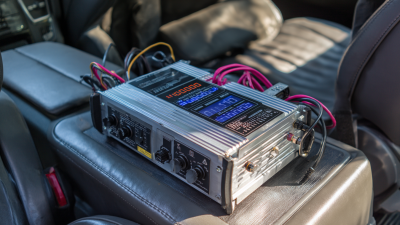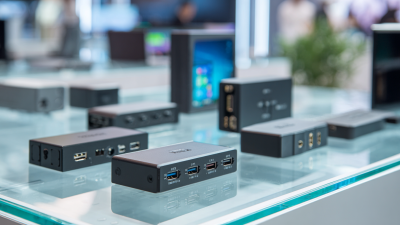
-
Home
-
About Us
-
Products
-
Total Solution
-
News
-
Blog
-
Contact Us
Leave Your Message
-
-
Phone
-
E-mail
-
Whatsapp
-
Whatsapp



When embarking on a road trip, having the right equipment can make all the difference in ensuring a smooth and enjoyable experience. Among the essential gadgets, a car inverter stands out as a vital tool for powering electronic devices on the go. According to a recent report by the Automotive Electronics Association, the market for car inverters is expected to grow at a CAGR of 6.5% over the next five years, indicating a strong demand for these devices among modern travelers.
As industry expert, Dr. Michael Anderson, notes, “A reliable car inverter not only keeps your devices charged but also enhances the overall travel experience by providing essential power when you're away from traditional outlets.” Whether it's charging your smartphone for navigation or powering up a laptop for work during a long journey, understanding the various types and features of car inverters can significantly impact your travel comfort and connectivity.
This guide aims to equip you with the knowledge you need to choose the best car inverter tailored to your specific road trip needs, ensuring that your adventure is both convenient and enjoyable. As we delve into the factors to consider when selecting a car inverter, remember that making an informed choice will allow you to focus on the road ahead.

Car inverters are essential devices for road trips, as they convert the DC power from your vehicle’s battery into AC power, allowing you to charge and operate various electronics. Essentially, these inverters enable you to use household appliances in your car, making them invaluable for long journeys where access to traditional power outlets is limited. By plugging your devices into the inverter, you can power anything from laptops to small kitchen appliances, enhancing your travel experience.
Understanding how car inverters work is crucial for choosing the right one for your needs. The inverter takes the direct current (DC) produced by your car’s electrical system and transforms it into alternating current (AC), which is what most appliances require. Inverters are categorized by their output type: modified sine wave and pure sine wave. Modified sine wave inverters are generally less expensive and suitable for less sensitive devices, while pure sine wave inverters provide cleaner power and are ideal for sensitive electronics. Ensuring you choose the right type will help you avoid damage to your devices and ensure your comfort on the road.
| Feature | Description | Power Output (Watts) | Number of Outlets | Input Voltage | Portability |
|---|---|---|---|---|---|
| Basic Car Inverter | Ideal for charging small devices like phones and tablets. | 150W | 1 | 12V | Very Portable |
| Medium Power Inverter | Suitable for laptops and other medium power devices. | 300W | 2 | 12V | Portable |
| High Power Inverter | Can run appliances like microwaves and TVs. | 800W | 3 | 12V | Less Portable |
| Heavy-Duty Inverter | For commercial use, suitable for multiple high-demand devices. | 1500W | 4 | 12V | Bulky |
| Multiple USB Ports Inverter | Designed for quick charging of multiple USB devices. | 200W | 1 (with USB ports) | 12V | Very Portable |
When selecting the best car inverter for your road trips, there are several key features to consider to ensure a
smooth and efficient experience. First and foremost, pay attention to the inverter's
power output, typically measured in watts. This will determine what devices
you can charge simultaneously and avoid overloading the inverter. A
higher wattage is essential if you plan to power high-demand appliances like laptops,
mini-fridges, or other electronics.
Another critical feature is the type and number of outlets available. Look for inverters that provide
both AC and USB ports to accommodate various devices. Additionally, features such as
built-in safety mechanisms—like surge protection and short-circuit prevention—are essential
for safeguarding your electronics while on the road. A
compact and portable design will also enhance usability, allowing you to easily store
the inverter when it’s not in use. By prioritizing these key specifications, you can make an informed decision that
enhances your travel experience.
When embarking on a road trip, having a reliable car inverter can make all the difference in keeping your devices powered up. With numerous options available, it’s crucial to select the right one that meets your needs. Here, we’ll explore the top 5 car inverters that are ideal for powering your devices while you’re on the go.
First on the list is the BESTEK 300W Power Inverter, known for its compact design and high output capability. With two AC outlets and four USB ports, it allows multiple devices to charge simultaneously, perfect for family trips.
Next is the Foval 150W Inverter, a lightweight and portable option that’s great for charging laptops and smartphones. It features a built-in fuse for safety, making it a great choice for those who prioritize security.
The third recommendation is the SOYOND 250W Inverter, which offers a durable design and a cooling fan to prevent overheating. Additionally, the JACKYLED 200W Inverter stands out with its sleek, modern appearance and has protections against overload and short circuits.
Lastly, the EnerPlex 110W Pocket Inverter is perfect for minimalists, providing ample power in a compact package that easily fits into any travel bag. Each of these options ensures that your devices stay charged throughout your journey, allowing for a worry-free travel experience.
When choosing a car inverter, it’s important to consider the different types available and their respective pros and cons. The most common type is the modified sine wave inverter, which is generally more affordable and suitable for basic devices like phone chargers and small appliances. However, they may not provide sufficient power for sensitive electronics. On the other hand, pure sine wave inverters offer clean and stable power, making them ideal for laptops and medical devices. While they come at a higher price, their reliability and compatibility with a broader range of electronics may justify the investment for frequent road trippers.
Tips for selecting the right car inverter include checking the wattage requirements of your devices before making a purchase. It’s essential to choose an inverter that can handle more than your total wattage to avoid overloading. Additionally, consider the size and portability of the inverter; a compact design is easier to store in your vehicle. Finally, look for built-in protection features such as overheating and short circuit protection, ensuring safe usage during your journeys.
When embarking on a road trip, using a car inverter can enhance your experience by allowing you to power devices on the go. However, ensuring safety is paramount. Here are some essential safety tips to keep in mind when using car inverters.
First, always check the inverter's wattage capacity. It’s important to match the power requirements of your devices to the inverter to prevent overloading and potential hazards. A safe practice is to reserve about 20% of the inverter’s capacity to avoid straining the unit. Additionally, make sure the inverter is well-ventilated and not placed in an enclosed space, as overheating can lead to malfunction.
Secondly, avoid using the inverter while the car is off. Most inverters draw power directly from the car battery, and running them without the engine can quickly drain your battery, leaving you stranded. To prevent this, only use the inverter when the vehicle is running, ensuring the alternator replenishes any power being consumed. Always monitor the battery level and be aware of any warning lights on your dashboard. By following these tips, you can safely enjoy the convenience of a car inverter on your adventures.





